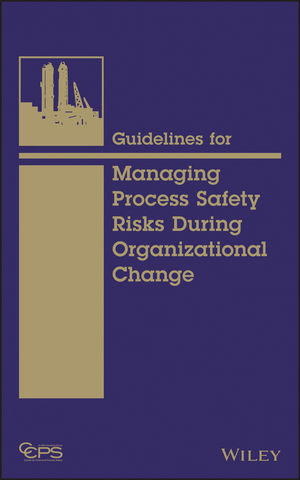
Guidelines for Managing Process Safety Risks During Organizational Change
Wiley-AIChE (Verlag)
978-1-118-37909-7 (ISBN)
An understanding of organizational change management (OCM) an often overlooked subject is essential for successful corporate decision making with little adverse effect on the health and safety of employees or the surrounding community. Addressing the myriad of issues involved, this book helps companies bring their OCM systems to the same degree of maturity as other process safety management systems. Topics include corporate standard for organizational change management, modification of working conditions, personnel turnover, task allocation changes, organizational hierarchy changes, and organizational policy changes.
Since 1985, the Center for Chemical Process Safety (CCPS) has been the world leader in developing and disseminating information on process safety management and technology. CCPS, an industry technology alliance of the American Institute of Chemical Engineers (AIChE), has published over 80 books in its process safety guidelines and process safety concepts series, and over 100 training modules through its Safety in Chemical Engineering Education (SACHE) series.
List of Tables xi
List of Figures xiii
Files on the Web Accompanying This Book xv
Acronyms and Abbreviations xvii
Glossary xxi
Acknowledgements xxiii
Preface xxv
Introduction and Scope 1
1.1 Case Study- Hickson and Welsh LTD, England (1994) 1
1.2 Introduction 3
1.3 The Need for Management of Organizational Change 5
1.4 Organization of the Book 6
1.5 A History of Organizational Change Management 11
1.6 Definitions Related to Management of Organizational Change 16
Corporate Standard for Organizational Change Management 21
2.1 Case Study – BP – Grangemouth, Scotland (2000) 21
2.2 OCM Background 24
2.3 Management Commitment 25
2.4 OCM Policy 26
2.5 OCM Workflow 27
2.6 OCM Procedure 28
2.7 Definition of Organizational Change 29
2.8 Roles and Responsibilities 32
2.9 Initiate an Organizational Change 32
2.10 Review the Change 34
2.11 OCM Risk Assessment 35
2.12 Action and Implementation/Transition Plans 55
2.13 Post-Implementation Monitoring 59
2.14 Closeout 61
2.15 Conclusion 61
Modification of Working Conditions 65
3.1 Case Study – Esso – Longford, Victoria, Australia (1998) 65
3.2 Modifying location, communication, or time allocation for people 68
3.3 Case Study – Changes in shift schedules and staffing during turnarounds 69
3.4 Changes to terms and conditions of employment (e.g. hours, shifts, allowable overtime) 72
3.5 Staffing during turnarounds, facility-wide emergencies, or extreme weather events 74
3.6 Impacts and Associated Risks 76
3.7 Special Training Requirements 79
3.8 Conclusion 80
Personnel Changes 83
4.1 Case Study – Union Carbide – Bhopal, India (1984) 83
4.2 Case Study – Bayer CropScience, LLC – Institute, West Virginia, USA (2008) 87
4.3 Changes in Plant Management, Such as Plant Manager or EHS Manager 91
4.4 Replacement of a Subject Matter Expert (SME) 92
4.5 Replacing the Incumbent in a Position that Directly Affects Process Safety 93
4.6 Strikes, work stoppages, slowdowns, and other workforce actions 93
4.7 Emergency Response Team Staffing 95
4.8 Impacts/Associated Risks 95
4.9 Organizational Change Procedures versus OCM for new hires, promotions, etc. 97
4.10 Conclusion 98
Task Allocation Changes 99
5.1 Downsizing Examples 99
5.2 Task Allocation Changes 101
5.3 Job Competency Change 102
5.4 Case Study – Bayer CropSscience LLC – Institute, West Virginia, USA (2008) 103
5.5 Assigning New Responsibilities 105
5.6 Temporary Backfilling 106
5.7 Vanishing Task Allocations 106
5.8 Case Study – BP – Whiting, Indiana, USA (1998 – 2006) 107
5.9 Impacts/Associated Risks 109
5.10 Conclusions 111
Organizational Hierarchy Changes 113
6.1 Centralization or Decentralization of Job Functions 114
6.2 Case Study – Esso – Longford, Victoria, Australia (1998) 115
6.3 Reorganizations and De-layering the Hierarchy 117
6.4 Impacts/Associated Risks 119
6.5 Changes to Span of Control 121
6.6 Impacts/Associated Risks 122
6.7 Linear vs. Matrix Organization 122
6.8 Case Study – BP, Texas City, Texas, USA (2005) 124
6.9 Impacts/Associated Risks 126
6.10 Acquisitions, Mergers, Divestitures, and Joint Ventures 127
6.11 Case Study – Anonymous, USA (1998) 127
6.12 Associated Risks 128
6.13 Case Study – Union Carbide, Bhopal, India (1984) 129
6.14 Changing Service Providers 132
6.15 Impacts/Associated Risks 132
6.16 Conclusion 133
Organizational Policy Changes 135
7.1 Case Study – Dupont, Delaware, USA (1818) 135
7.2 Changes to Mission and Vision Statements 136
7.3 New and Revised Corporate Process Safety Related Policies/Procedures 138
7.4 Major Changes to Policy of Budgets for Maintenance or Operations 139
7.5 Impacts/Associated Risks 140
7.6 In/Outsourcing of Key Departmental Functions Such as Engineering Design or Maintenance 142
7.7 Staffing Level Policy Changes (shutdowns, turnarounds, startups) 144
7.8 Special Training Requirements 146
7.9 Conclusion 146
Appendix A. Example Tools for Evaluating Organizational Changes 149
Appendix B. Example Procedures for Managing Organizational Changes 199
Index 236
| Sprache | englisch |
|---|---|
| Maße | 163 x 241 mm |
| Gewicht | 481 g |
| Themenwelt | Naturwissenschaften ► Chemie ► Technische Chemie |
| Technik ► Umwelttechnik / Biotechnologie | |
| Wirtschaft | |
| ISBN-10 | 1-118-37909-8 / 1118379098 |
| ISBN-13 | 978-1-118-37909-7 / 9781118379097 |
| Zustand | Neuware |
| Haben Sie eine Frage zum Produkt? |
aus dem Bereich


